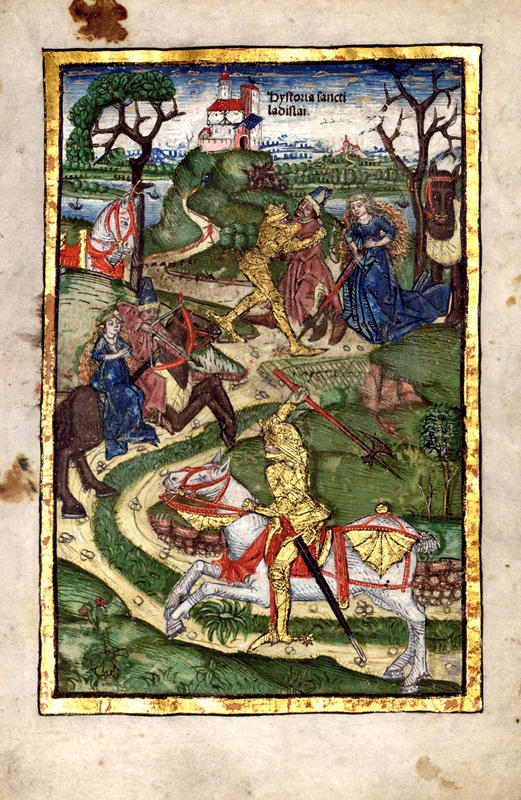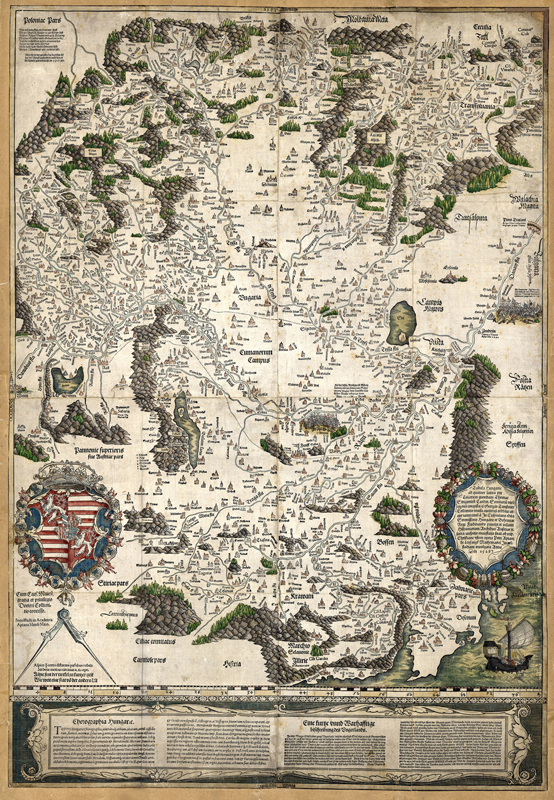
Early Printed Books
 This archive keeps the earliest printed documents of Hungary’s national library. Parts of the collection had been built gradually, since the second half of the 19th century. The first such part was the Incunabulum Collection which contains books printed before December 31, 1500. In 1865, incunabula were placed, as a separate collection, in the elegant and newly built Széchényi Room of the Hungarian National Museum which then served as a home for National Széchényi Library. At the beginning of the 20th century, documents belonging to the so-called Old Hungarian Library, i.e. publications published in Hungarian before 1711, printed in Hungary or publications written by a Hungarian author in a foreign language somewhere abroad. The third collection had been donated by Count Sándor Apponyi (1844-1925) to National Széchényi Library. Apponyi’s Hungarica Collection includes printed Hungary-related works by foreign authors, published before 1800. The fourth part of the archive, the Antiqua Collection covers foreign printed books from the 16th century, and it has existed as a separate collection only for some decades. Materials have been selected from NSZL’s General Collection. In addition to the afore-mentioned four big units, Early Printed Books Archive is also enriched by a couple of smaller parts of the collection.
This archive keeps the earliest printed documents of Hungary’s national library. Parts of the collection had been built gradually, since the second half of the 19th century. The first such part was the Incunabulum Collection which contains books printed before December 31, 1500. In 1865, incunabula were placed, as a separate collection, in the elegant and newly built Széchényi Room of the Hungarian National Museum which then served as a home for National Széchényi Library. At the beginning of the 20th century, documents belonging to the so-called Old Hungarian Library, i.e. publications published in Hungarian before 1711, printed in Hungary or publications written by a Hungarian author in a foreign language somewhere abroad. The third collection had been donated by Count Sándor Apponyi (1844-1925) to National Széchényi Library. Apponyi’s Hungarica Collection includes printed Hungary-related works by foreign authors, published before 1800. The fourth part of the archive, the Antiqua Collection covers foreign printed books from the 16th century, and it has existed as a separate collection only for some decades. Materials have been selected from NSZL’s General Collection. In addition to the afore-mentioned four big units, Early Printed Books Archive is also enriched by a couple of smaller parts of the collection.
Incunabulum Collection
NSZL’s Incunabulum Collection holds over 1,800 copies of books printed during the first 50 years of book printing, which means nearly 25 percent of Hungary’s total incunabulum stock (roughly 7,100 items). One of the outstanding treasures of the collection is a fragment from the first European printed book, Gutenberg’s 42-line Bible, together with Decretum Gratiani printed in black and red by Peter Schöffer, an apprentice of Gutenberg, in 1472. Another famous item of the collection is an Aristotle edition in Greek printed by the famous Venetian publisher and printer Aldus Manutius. NSZL’s Incunabulum Collection holds Chronica Hungarorum, the first book printed in Hungary, in 1473 by András Hess of Buda. A rare item of the collection is Missale Glagoliticum published in 1494 in Zengg (Senj), being the most complete existing copy of the work. Thuróczy-krónika (Thuróczy Chronicle) held in NSZL’s Incunabulum Collection may well be a copy made for King Matthias and Queen Beatrix. It is printed on parchment, is illustrated with richly gold-plated and hand-painted miniatures; the chronicle was published in 1488 in Augsburg. Schedel-krónika (Schedel Chronicle) printed in 1493 in Nuremberg features a wonderful wood print showing what Buda Castle looked like during the reign of King Matthias. The only known copy of the first printed historical work about Dracula, the infamous count of Wallachia, is also kept in the Incunabulum Collection of National Széchényi Library.
Read more
Antiqua Collection
NSZL’s Antiqua Collection, covering materials from the 16th century, includes academic works and fiction by classical writers, humanists and authors of the Age of Reformation. The 13,000-item collection also provides an excellent historical resource on the subject of wars against the Turks. Especially beautiful volumes are Underweysung der Messung mit dem Zirckel (Nuremberg, 1525), illustrated with woodcuts by Albrecht Dürer, and the eye-catching botanical works of the archive. One of the especially rare copies is a 1st edition of the prophecy of 16th-century French astrologist Nostradamus.
Old Hungarian Library
Including more than 8,500 items, Old Hungarian Library is Hungary’s richest collection of old Hungarian books. It includes Hungary’s earliest printed texts in Hungarian, e.g. Benedek Komjáthy’s translation of the Letters of Saint Paul and the first Hungarian-language book printed in Hungary, János Sylvester’s translation of the New Testament, published in 1541 by a printing house set up in Sárvár-Újsziget. NSZL’s Old Hungarian Library contains printed memories of Reformation and the Hungarian Baroque, editions of Gáspár Heltai, Péter Bornemissza, Sebestyén Tinódi, Péter Pázmány and Miklós Zrínyi, both academic and popular publications, published until the Peace of Szatmár putting an end to Rákóczi Fight for Freedom in 1711. In Old Hungarian Library you can find the first complete edition of the Bible in Hungarian, translated by Gáspár Károlyi and others and published in 1590 in Vizsoly. The most significant growth of Old Hungarian Library came as a result of a generous donation by a bibliophile couple, Gyula Todoreszku (1866-1919) and Aranka Horváth, who offered their collection to National Széchényi Library in 1919.
Apponyi Collection
 National Széchényi Library owes its Hungarica Collection to Count Sándor Apponyi (1844-1925) who, in his will worded in 1924, donated his personal library to the national library.
National Széchényi Library owes its Hungarica Collection to Count Sándor Apponyi (1844-1925) who, in his will worded in 1924, donated his personal library to the national library.
From his early youth, Count Apponyi had enthusiastically collected Hungary-related books in foreign languages, from the beginnings of printing to the end of the 18th century. Since he had come from a family of high-ranking diplomats, Apponyi could spend decades in major cities of Europe, mainly in London and Paris. In the course of his long life, he collected publications with the diligence of a scholar. Count Apponyi’s over 3,000-item hungarica library comprises Hungary-related works by foreign authors published before 1800. His library includes a bulk of rare items: in addition to books, some pamphlet-like publications as well. A good example of the latter genre is a one-time report in French on the Battle of Mohács, the copy of which in Apponyi’s collection had been purchased by the son of Fernando Colombo, i.e. Christopher Columbus, in Lyon. Especially rich is the material on wars against the Turks in the 16th and 17th centuries, on Thököly Uprising and about Rákóczi Fight for Freedom. Adjacent to the Apponyi Hungarica Collection is the Count’s well-known collection of woodcuts which, by way of depicting certain events of the Hungarian history, is a major source for historical research. This collection keeps the earliest printed map of Hungary, Lazarus’ Map in woodcut, published in 1528 in Ingolstadt. Lazarus’ Map is one of the most significant cartographic publication of the age, which, due to its rich material of place names, is an especially significant historical source for researchers.
Smaller collections
Leaflet Collection is a smaller but also significant collection of National Széchényi Library, which has been detached from the Library’s General Collection and which comprises period printed reports about historical events in Hungary, from the beginnings up until 1718. Old Cyrillica Collection is a generous donation of Gyula Todoreszku and has a great significance since it contains mainly old Rumanian cyrillicas, mostly liturgical books, from the 17th-18th centuries. Early Printed Books Archive also includes a minor collection of Ex libris items of Hungarian book collectors and libraries, made before 1900. The History of Binding Collection gives an overview of the various periods in the history of Hungarian bookbinding. As time went by, the collection gradually grew to be a universal one. In the next few years, it will also grow by way of registering volumes, important and precious from the historical point of view, to be found in other collections of National Széchényi Library.
Book and Cultural History Research Group
The Book and Cultural History Research Group works within the frames of the Early Printed Books Collection and compiles and maintains the retrospective national bibliography from 1473–1800. The Old Hungarian Printed Works provides a detailed description, in chronological order and based on autopsy, of the works published in Hungarian, in whole or in part, or in any language within the territory of historical Hungary published from 1473 to 1700. It also continues Géza Petrik’s work entitled Bibliography of Hungary with supplementary volumes to cover the period 1701–1800. Data that have not yet been published can be searched using locally available registers.
The Research Group is also expanding the bibliography of personal hungarika documents for the whole period (RMK III). It compiles and publishes the database of Old Hungarian Authors 1701–1800. It conducts research on the history of typography and cultural history, and on the basis of this research it is building the Clavis Typographorum Regionis Carpathicae 1473–1948, the Typographia databases and the Hungaria Typographica series, which covers the typographic material of all Hungarian printing houses.



